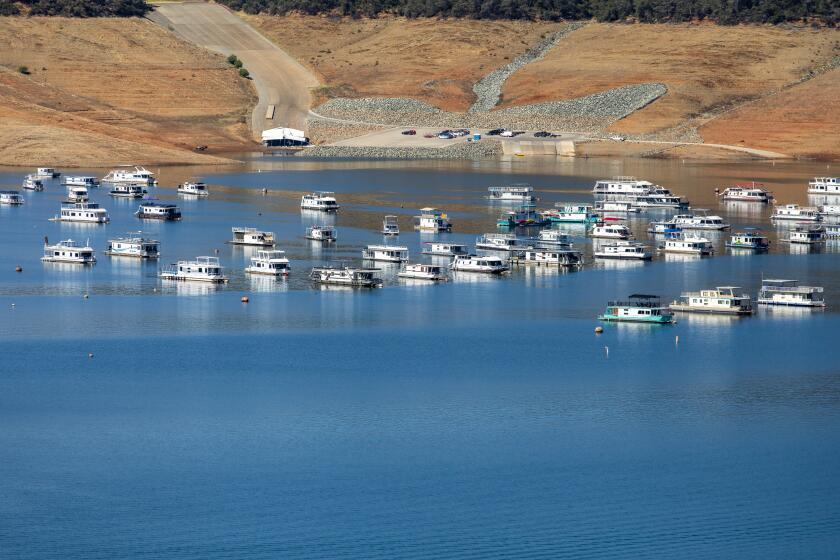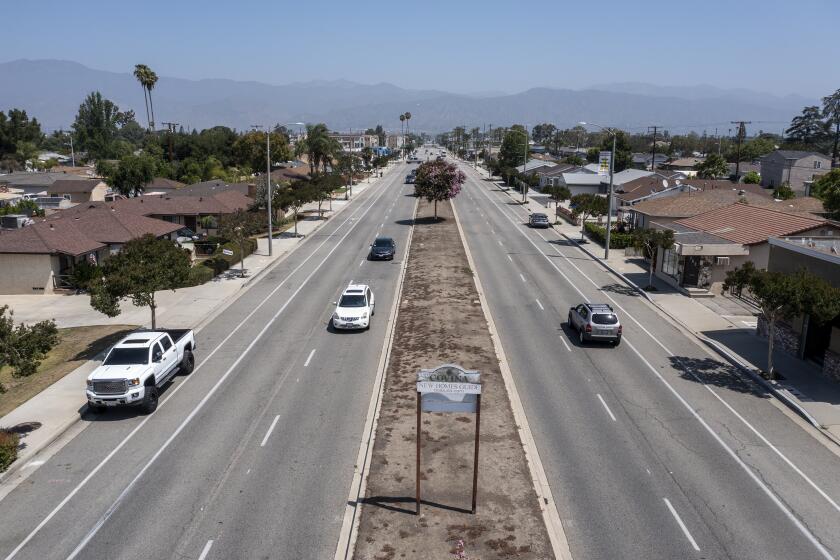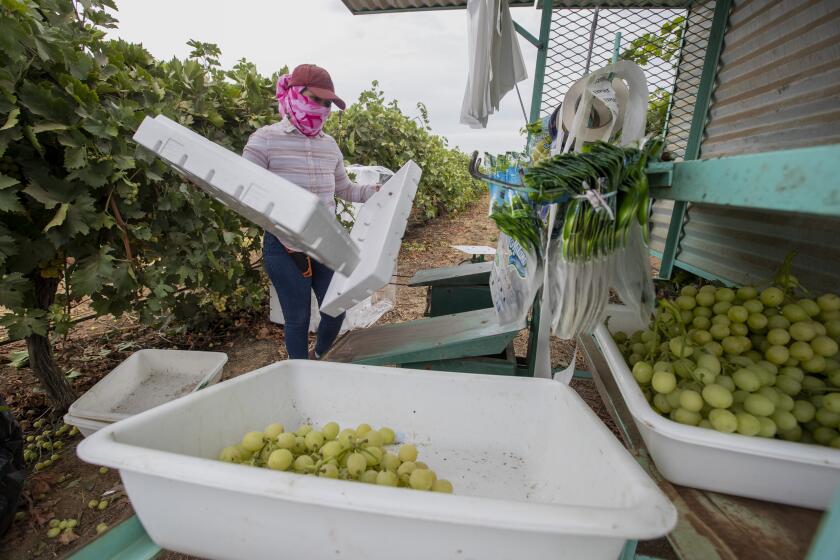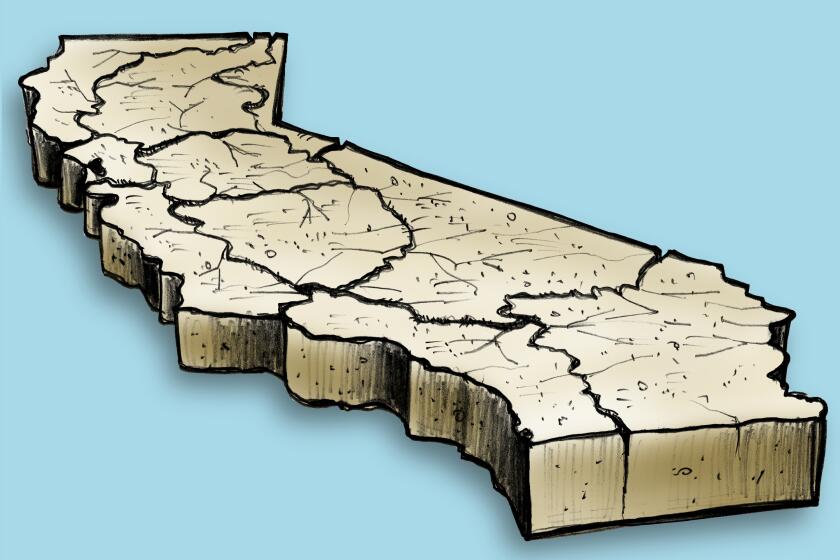California drought pits farmers vs. cities. But neither is the biggest water victim
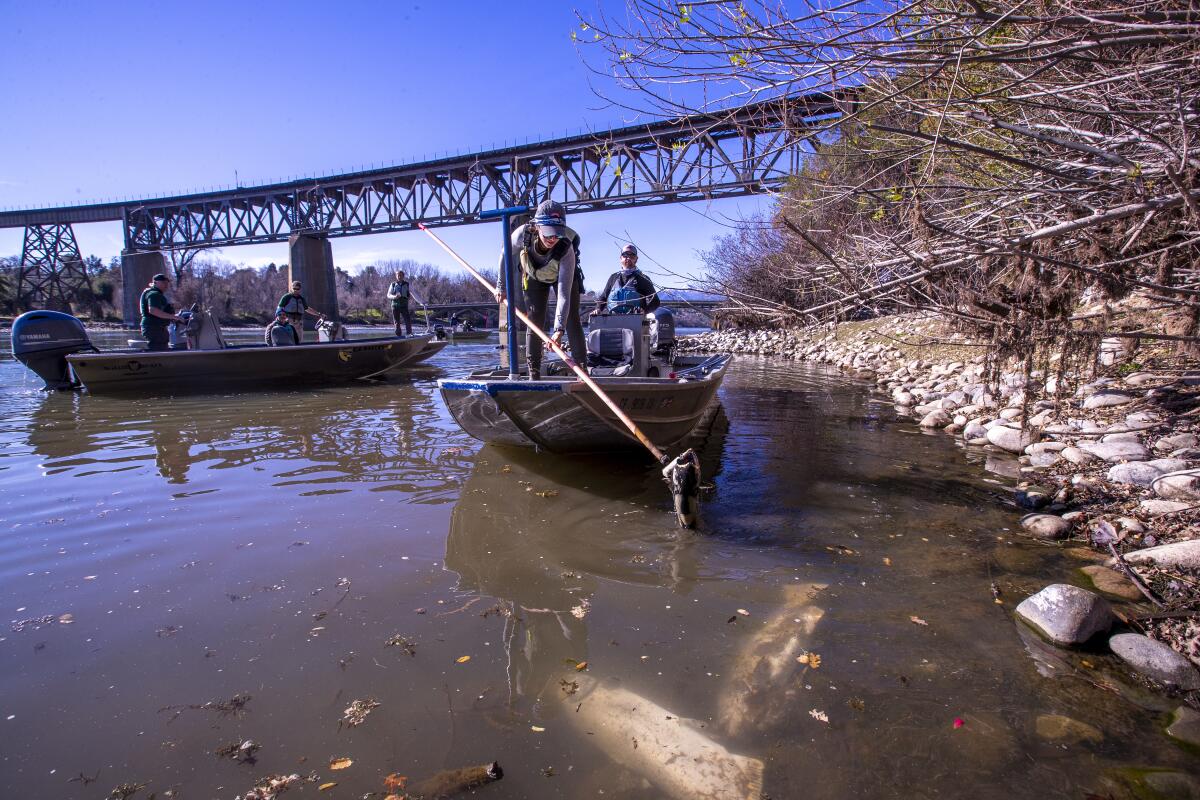
- Share via
As California fast approaches what is likely to be a fourth year of punishing drought, residents are being asked to cut water use to historic lows. But while city dwellers are rising to the occasion — including record reductions in Los Angeles in August — urban consumption represents only a small fraction of total water use in the state.
Where the rest of it goes depends on whom you ask. The California Department of Water Resources says 50% of the state’s water goes for environmental purposes, 40% for agriculture and 10% to urban areas.
But experts say that calculation tells only part of the story, because the environment’s share tends to shrink dramatically during dry years. Instead, a clearer picture begins to emerge when one considers water designated for domestic and business use: Of that, 80% goes toward agriculture and 20% to urban areas.
While agriculture’s share may seem outsize to urban residents being asked to let their lawns go brown, experts say the sector is dealing with cuts, shortages and shifts brought on by drought and climate change, even as it continues to play a major role in feeding the state and nation. California’s environment, meanwhile, is often overlooked in the noisy debate over urban and agricultural water use, as its constituents — plants, animals, rivers and aquifers — have little voice in the matter.
The 50-40-10 breakdown “is misleading,” said Peter Gleick, co-founder and senior fellow of the Pacific Institute. “Because, first of all, it implies that we, as a society, have made a decision to give half of the water to the environment. When what’s in fact the reality is that we have taken 50% of the water from the environment. The environment used to have it all.”
More dryness, extreme weather events and water quality hazards are likely in 2023, state water officials said Wednesday.
That’s not to say that environmental water doesn’t still play an important role in California. Each year, the state’s water managers are tasked with doling out enough supplies to maintain scenic rivers, managed wetlands and wildlife habitats, as well as the salinity of sources used by farms and cities.
But the accounting system is based on a normal year, and in California, those are increasingly rare. When the state faces dry conditions, the environment is among the first to take a hit, and that can have harsh consequences for wildlife.
Last year, for example, limited environmental releases from Shasta Lake caused river levels to drop and waters to grow warmer — conditions that are inhospitable to Chinook salmon. Officials have taken to trucking the fish, which are at risk of extinction, to cooler waters, where they have a better chance at survival.
Jeffrey Mount, a senior fellow at the Public Policy Institute of California, said it is all part of an annual equation made more delicate by worsening drought conditions and the demands of urban and agricultural water users. Critically, 3.5 million to 4 million acre-feet of water must flow out of the Sacramento-San Joaquin Delta — a linchpin of the state’s system that provides water to millions of Californians — or else “the delta gets too salty for people to use it,” Mount said.
In 2021, the bulk of the water that ran off the surface of the Sacramento and San Joaquin Delta watershed was used for agriculture, Mount said. The water Southern California received was primarily from reservoirs, “and there was almost nothing for the environment.”
“It is a mistake to actually blend the environment into the discussion,” he said. “That’s why the 50-40-10 number is so misleading and probably is not the thing we should be talking about. But it is fair to discuss the relationship between what we call consumptive use of water — that is, water to support domestic and business uses in California. And that 80% number for agriculture is correct.”
Officials are lauding the city’s progress, but some experts ponder the long-term plan — especially as seasonal outlooks indicate yet another dry winter is in store for Southern California.
While it may be tempting to vilify agriculture for its massive share, the sector plays an invaluable role in the nation’s food supply, Mount and other experts said. Though agriculture accounts for only about 3% of the state’s gross domestic product, it contributes about 13% of agricultural production nationwide — more than any other state. In some ways, the water proportion makes sense.
“It’s hugely imbalanced, but it also is sort of logical because of history and because of economics,” Gleick said.
Part of the reason agriculture uses such a massive share of the state’s water is that it is consumptive, Gleick explained — meaning most water used by crops does not make it back into the system. By contrast, water that runs down a bathroom sink can be captured, treated and reused for other purposes.
The consumptive nature of agriculture is the same reason outdoor watering is among the first cuts to be made in urban areas, where an estimated 44% of water goes toward irrigating lawns and other uses outside the home. In Southern California, for example, officials this summer limited outdoor watering for millions of residents to one or two days a week and saw a significant reduction in demand as a result.
But the total volume of water is only one metric for considering agriculture’s share, according to Isaya Kisekka, a professor of agricultural water management at UC Davis. Instead, he said, the best way of quantifying use is to examine nutritional water productivity — how much protein, nutrients and calories are produced by a unit of water.
Farmers also consider economic water productivity — or how much economic value is produced by that unit of water — which “has been increasing in the state for a few years now,” Kisekka said. “That’s when crops like almonds, pistachios, grapes come into play, and that’s why you’ve seen a lot of growers shift to these crops, because they have very high economic water productivity.”
Indeed, the state in recent years has seen a dramatic swing away from field crops such as wheat, cotton and alfalfa toward fruits, vegetables and nuts. Production of cotton in 2020, for example, was down 26% from the year before, while pistachios and almonds were up 41% and 22%, respectively, according to the California Department and Food and Agriculture.
More than 6 million Southern Californians will be placed under new drought rules today in an unprecedented effort to conserve water.
The reason for that shift is primarily economic, Mount said.
“Agriculture is not some public trust resource that belongs to everybody,” he said. “Agriculture is run by businessmen and -women, and they seek to maximize profits on their throughput.”
But its footprint is shrinking, especially as the state ramps up enforcement of the Sustainable Groundwater Management Act, a 2014 law aimed at reducing the pumping of groundwater from beneath the Earth’s surface. (During dry years, farmers tend to lean heavily on underground supplies, a practice that is leading to a host of problems, including drying wells and subsidence.)
The act “changes everything, because they’ve been mining groundwater for a hundred years, and now they have to stop doing that,” Mount said of farmers. “Right there, that’s 500,000 to 700,000 acres of irrigated land that has to come out of production to meet the requirements of that law.”
Last year, severe drought and reduced water deliveries resulted in 395,000 acres of California cropland — an area larger than Los Angeles — going dry and unplanted, costing an estimated 8,745 jobs and $1.2 billion in direct costs. This year’s impact could be even larger, with researchers projecting that nearly 800,000 acres may be fallowed, including about half of the state’s rice acreage.
That could have disastrous and unintended consequences for migratory birds, which rely on flooded rice fields during their annual fall migration, Mount said.
California’s agriculture industry saw $1.2 billion in costs and the loss of more than 8,700 jobs due to drought last year, according to a new research.
Driven by nature and economics, farmers are improving their irrigation practices, Kisekka said. That includes shifting away from flood irrigation — the practice of literally flooding fields — and toward drip irrigation, which doles out one drop at a time.
However, conditions are more dire than at almost any time on record: The state appears poised to enter yet another year of drought, pressure is mounting on Southern California to slash its use of Colorado River water, and warming temperatures driven by human-caused climate change are continuing to evaporate more surface water. Additionally, another round of severe reductions in water allocations from state and federal suppliers is looking increasingly likely in 2023.
As with other sectors, “agricultural water users have experienced unprecedented cuts to both their surface water diversions and allocations from the state and federal water projects since the governor’s first drought proclamation in April 2021,” Steve Lyle, director of public affairs for the California Department of Food and Agriculture, said in an email. He said allocations from the projects have at times been “as little as five percent of contracts.”
While California has a framework to control allocations, it cannot go so far as to tell farmers what crops they should grow. Alfalfa, for example, saw a 22% increase in production in 2020, despite being water-intensive.
Kisekka said farmers have continued to grow alfalfa — and export it to other states and nations — because demand remains “sky high,” and prices have been soaring. Many dairies, feed lots and other operations use alfalfa in their feed rotations.
The state is also somewhat stymied when it comes to water rights, which in California have long operated under an antiquated system sometimes referred to as “first in time, first in right,” which essentially means that water rights are doled out based on whoever was first in line, Mount said.
“There is authority to take water away from people, but you have to make a very compelling case that it’s waste and unreasonable use,” he said, adding that the laws are very clear that “growing a crop is not viewed as waste and unreasonable use.”
The rules have long been a battleground in the state, with some farmers quick to fight against curtailments and other efforts to reduce their use. Gov. Gavin Newsom’s water supply strategy, released in August, drew criticism from experts for its apparent unwillingness to take on “Big Ag.”
“It’s long past time to revamp the water rights rules in California, but to say that that’s a heavy lift politically would be an understatement,” said the Pacific Institute’s Gleick.
The latest maps and charts on the California drought, including water usage, conservation and reservoir levels.
That doesn’t mean urban users are off the hook. While farmers have been scrutinized for using the state’s water to grow crops that are exported overseas, Californians also import immense amounts of water — often in the form of manufactured goods, such as cars, lumber and even craft beers, Mount said.
Kisekka added that a lot of water is represented in the meals on Californians’ plates, and “we should make sure we are not throwing away food.”
While agriculture’s 80% share strikes a nerve among some, it’s not all that different from usage elsewhere in the world. Both nationally and globally, about 70% to 80% of water goes toward agriculture.
As for whether an almond orchard should take precedence over an urban lawn — that probably depends on whom you ask, Gleick said.
“It’s understandable that a homeowner asked to let their beautiful lawn go dry sees farmers using 80% of the water, and they think, ‘Well, that doesn’t seem fair,’” Gleick said. “I completely understand that. It’s just not the way it really works. Farmers really do have, also, many challenges that they have to face during droughts.”
Put simply, he said, “agriculture uses a lot of water because it takes a lot of water to grow food.”
More to Read
Sign up for Essential California
The most important California stories and recommendations in your inbox every morning.
You may occasionally receive promotional content from the Los Angeles Times.
